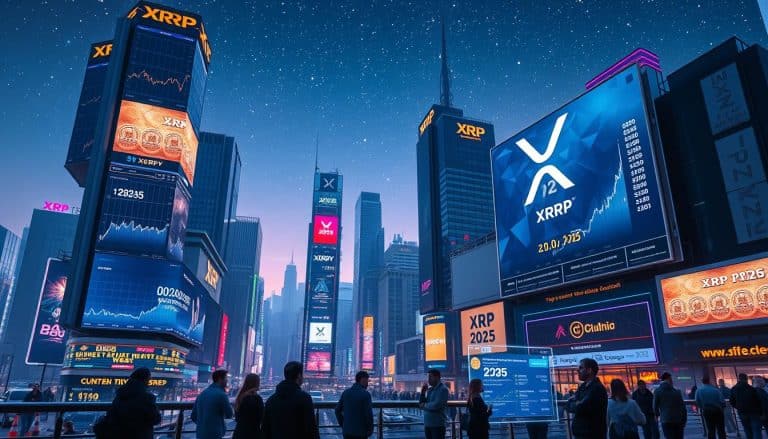Xrp Price Outlook
Ripple (XRP) is a cryptocurrency developed by the Ripple Company, which was founded in 2012. It is one of the most popular digital currencies on the market and has experienced significant growth since its launch. The price of XRP has fluctuated over time, depending on various factors such as news announcements, trading activities, and market sentiment. In this article, we will explore the historical performance of XRP and discuss potential factors that may influence its price in the future. We will also analyze how investors can use current data to make informed decisions when it comes to investing in XRP. Finally, we will look at some of the pros and cons of investing in this digital currency so that readers can make an educated decision when considering their investment options.
Overview of XRP
XRP, the native cryptocurrency of the Ripple payment network, has become a major player in the digital asset market since its launch in 2012. Its popularity is due to its low transaction fees and high scalability compared to other cryptocurrencies. However, there have been security implications associated with XRP that need to be addressed before it can achieve full adoption. Additionally, scalability challenges have been identified as a potential barrier for long-term success. Nonetheless, the cryptocurrency remains one of the most popular digital assets on the market today and continues to draw attention from investors and traders alike. Moving forward, historical price performance will provide insight into XRP’s future outlook.
Historical Price Performance
Ripple’s historical performance has been a rollercoaster of highs and lows, demonstrating the digital asset’s volatility and potential for future growth. Market trends can affect XRP price fluctuations significantly. In 2017, XRP’s value rose from around $0.006 to an all-time high of $3.84 by the end of the year, representing more than 60000% in gains as investors poured into cryptocurrency markets during that period. The bear market of 2018 brought prices down to a low of $0.25 in December 2018 before recovering somewhat in 2019, when it traded between roughly $0.30 and 0.50 throughout most of the year before increasing again in late 2020 and early 2021 to its current level near $1 per coin. This demonstrates that there is potential for significant growth if market conditions are favorable; however, investors should also be aware that these types of rapid movements can go both ways, so caution should always be taken when investing in cryptocurrencies such as XRP. With this knowledge about Ripple’s historical performance in mind, it is important to consider what factors may influence XRP prices moving forward.
Factors Influencing XRP Price
The price of XRP is largely determined by supply and demand, adoption and usage, as well as the regulatory environment. Supply and demand are impacted by factors such as user sentiment, investment activity, market speculation, media coverage, and the availability of liquidity. Adoption and usage influence the price of XRP when its utilization increases in various areas such as retail payments or international money transfers. Lastly, changes to regulations across different jurisdictions can have a significant impact on how XRP is perceived by investors.
Supply and demand
Supply and demand of XRP have been highly volatile, significantly fluctuating with the changing market conditions. There are two main factors that drive the supply and demand of XRP: inflationary effects and liquidity issues. Inflationary effects refer to an increase in the amount of coins available for trading, while liquidity issues refer to the ability of traders to buy or sell large amounts at any given time without causing drastic price fluctuations.
The table below includes some examples of how these two factors can affect the supply and demand of XRP:
| Inflationary Effects | Liquidity Issues |
|---|---|
| Increase in coin supply | Difficulty buying/selling large volumes quickly |
| Increased competition for acquisitions | Lack of buyers/sellers in certain markets |
| Uncertainty over future value | Low daily trading volume |
These factors can have a significant impact on XRP’s price outlook and must be taken into account when considering whether or not to invest in it. With this information, we can now move on to discuss adoption and usage as a factor influencing its price.
Adoption and usage
Adoption and usage of XRP has been steadily increasing in recent years due to its low transaction fees and fast processing times. This is especially true with merchant integration, where XRP’s high liquidity sources make it an attractive option. Additionally, the use of XRP as a bridge currency between other currencies allows for faster transactions than if completed through traditional exchanges. As more merchants see the benefits of using XRP, adoption is likely to continue to grow. However, this growth could be affected by regulatory changes or movements in the markets that could ultimately affect demand and supply levels. With this in mind, understanding the regulatory environment surrounding XRP is necessary for predicting its future price outlook accurately.
Regulatory Environment
The regulatory landscape for XRP can influence the demand and supply levels of the asset, thus impacting its future performance. One of the key legal implications that could affect its price outlook is the potential designation of XRP as a security by global regulators. Such a designation would bring additional regulations, which could make it more difficult to trade, potentially leading to reduced demand and hence lower prices. Additionally, other global trends in cryptocurrency regulation such as increased scrutiny on Anti Money Laundering (AML) laws will also need to be taken into consideration when considering the future performance of XRP. To conclude, understanding the regulatory environment is critical in gauging how XRP may perform going forward. Subsequently, an analysis of market conditions can provide insight into the current and future price outlook.
XRP Price Outlook
Recent analysis of XRP prices suggest that the asset has seen an impressive increase of around 40% in its value over the past year, making it a potentially attractive option for traders. Technical analysis suggests that market sentiment around XRP is positive and investors are likely to experience strong returns if they invest in this cryptocurrency. Market sentiment is also being driven by the increasing use of XRP as a payment method among companies and individuals, which has resulted in increased liquidity and improved price stability. However, potential risks still remain when investing in XRP such as regulatory uncertainty and volatility due to its high risk nature. Thus, investors must be aware of these risks before investing in this asset class.
Potential Risks of Investing in XRP
Investing in XRP has the potential to be lucrative, but also carries certain risks that investors should consider before making an investment decision. These include:
- Market sentiment – Crypto markets are highly volatile and can shift quickly depending on news and rumors, so it’s important to stay informed of the current market sentiment before investing in XRP.
- Liquidity concerns – The liquidity of XRP may be limited compared to other popular cryptocurrencies, which can make it difficult or expensive to exit a position if needed.
- Regulatory risk – Regulations governing cryptocurrencies are constantly changing, which could have an impact on the price of XRP.
- Security risks – As with any asset, there is always a risk that someone will try to steal or hack your holdings. This risk is especially high in crypto due to its decentralized nature.
- Investing beyond one’s means- Investors should always ensure they are comfortable with taking on potential losses before investing in any asset class including XRP.
In conclusion, investors should carefully assess all these potential risks before making their investment decisions as it can help avoid unpleasant surprises down the road. To better understand how these factors may influence the future price movements of XRP, analyzing past price action can be helpful for predicting future trends.
Analyzing XRP Price Movements
The potential risks of investing in XRP are many and varied. The analysis of the current price movements thus becomes important for investors to understand how much risk is associated with their investments. To determine this, it is necessary to examine the security measures taken by Ripple and other institutions involved in the XRP trading as well as analyze decentralization trends that influence the price movements. Moreover, a thorough examination of the market environment is also essential for understanding whether there are any external forces that may affect XRP prices. By understanding these factors, an investor can make more informed decisions about their investments.
Furthermore, it is useful to look at historical data to get insight into the possible patterns that could develop over time in relation to XRP prices. This data can provide valuable information regarding past performance and potential future trends for investors looking to gain maximum returns from their investment in XRP tokens. By thoroughly analyzing all available data related to XRP prices, investors can better formulate strategies that maximize profits while minimizing losses due to sudden changes in market conditions or unexpected events. With such knowledge, they may then be able to make informed decisions on when it is best to purchase or sell their holdings of XRP tokens. In conclusion, examining both current and historical data allows investors to gain a better understanding of potential risks associated with investing in XRP and ultimately helps them decide if such investments are worthwhile or not. As such, a thorough analysis of price movements is essential for any investor looking at buying or selling Ripple’s digital asset. With this knowledge, one may proceed with weighing out the pros and cons of investing in XRP before making any definitive decision on whether they should invest or not.
Pros and Cons of Investing in XRP
Given the decentralized nature of cryptocurrency, investing in XRP tokens requires a thorough examination of potential risks and rewards. Volatility is one of the primary risks associated with XRP investments as the market value for such tokens is unpredictable and can fluctuate dramatically over time. This risk can be mitigated by diversifying an investment portfolio to ensure that any losses incurred due to volatility are not too great. Additionally, investors should consider the correlation between XRP prices and other markets when assessing potential returns on their investments. For example, if Bitcoin continues to rise in value, it could lead to increased demand for Ripple’s native token, which could result in higher returns as well. On the other hand, if Bitcoin prices decline significantly, then there may be a corresponding drop in XRP prices that would affect investor returns negatively. Therefore, understanding any correlations between different markets before investing is wise.
Frequently Asked Questions
What is the minimum amount of XRP I need to invest?
Investing in XRP requires careful market analysis and strategic investment planning. Factors such as current market trends, historical performance, and potential risks should all be taken into consideration when deciding on the minimum amount of XRP to invest.
Does XRP use blockchain technology?
Does Ripple technology leverage the power of blockchain to achieve network effects? By utilizing distributed ledger technology, it facilitates payments and exchanges between two parties without the need for a third-party intermediary. This results in faster, more secure transactions while providing scalability to meet the growing demands of global finance.
Are there any regulation risks associated with XRP?
XRP is subject to regulation risk due to its Ripple effect, which could cause liquidity concerns. Its decentralized nature and global reach can lead to potential regulatory issues that can affect the availability and valuation of XRP. Therefore, it is important to be aware of the legal ramifications for any investment in XRP.
What are the tax implications of investing in XRP?
Investors should be aware of potential capital gains taxes when investing in XRP. According to research, an estimated $41 billion in taxes have been paid on crypto investments since 2017. Investment strategies must consider these factors and plan accordingly.
Are there any other cryptocurrencies similar to XRP?
Technical analysis of supply and demand can be used to identify cryptocurrencies similar to XRP. Many factors such as market capitalization, trading volume, transaction speed, and potential for scalability must be taken into account when making a comparison.






 Bitcoin
Bitcoin  Ethereum
Ethereum  XRP
XRP  Tether
Tether  Solana
Solana  USDC
USDC  Dogecoin
Dogecoin  TRON
TRON  Lido Staked Ether
Lido Staked Ether  Cardano
Cardano  Hyperliquid
Hyperliquid  Stellar
Stellar  Wrapped Bitcoin
Wrapped Bitcoin  Sui
Sui  Wrapped stETH
Wrapped stETH  Chainlink
Chainlink  Hedera
Hedera  Bitcoin Cash
Bitcoin Cash  Avalanche
Avalanche  LEO Token
LEO Token  Wrapped eETH
Wrapped eETH  Shiba Inu
Shiba Inu  WETH
WETH  Toncoin
Toncoin  Litecoin
Litecoin  USDS
USDS  WhiteBIT Coin
WhiteBIT Coin  Monero
Monero  Polkadot
Polkadot  Binance Bridged USDT (BNB Smart Chain)
Binance Bridged USDT (BNB Smart Chain)  Coinbase Wrapped BTC
Coinbase Wrapped BTC  Pepe
Pepe  Ethena USDe
Ethena USDe  Uniswap
Uniswap  Bitget Token
Bitget Token  Aave
Aave  Bittensor
Bittensor  Dai
Dai  Pi Network
Pi Network  Aptos
Aptos  Cronos
Cronos  NEAR Protocol
NEAR Protocol  Ethena Staked USDe
Ethena Staked USDe  Internet Computer
Internet Computer  OKB
OKB  Ondo
Ondo  Jito Staked SOL
Jito Staked SOL  Ethereum Classic
Ethereum Classic  BlackRock USD Institutional Digital Liquidity Fund
BlackRock USD Institutional Digital Liquidity Fund